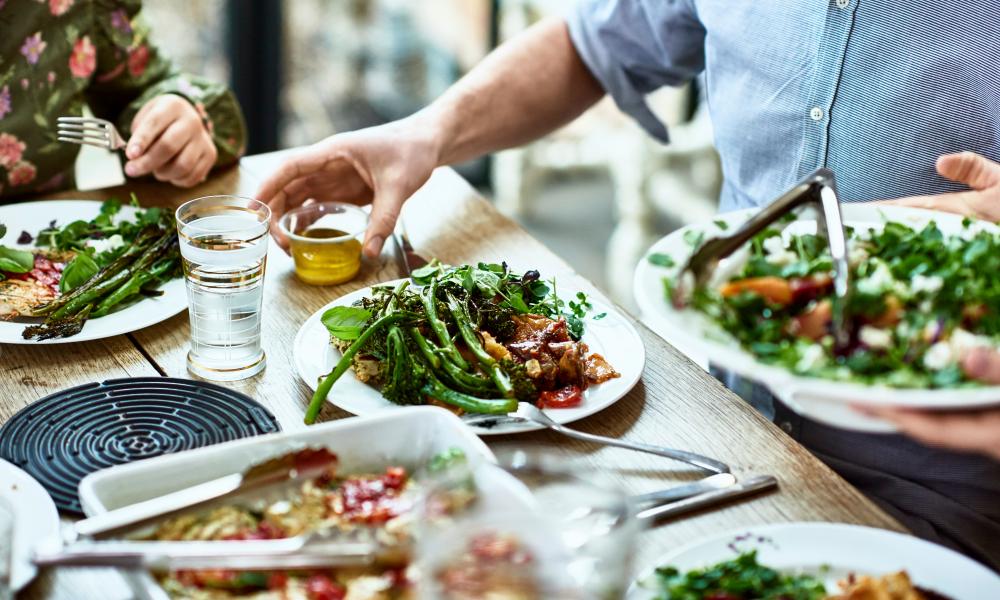
‘A DRIZZLE, A DOLLOP AND A CRUNCH’: THE SECRET TO PLANT-BASED EATING
I grew up in a multicultural household – my father is Norwegian, my mother Bulgarian and Danish – and spent my early years in Tanzania, where, in the 1980s, processed foods were practically nonexistent. If we wanted pizza, we made everything – from the base to the sauce – ourselves.
My mother made fresh butter and yoghurt, and I also spent a lot of my time with my “green-fingered” grandmother who lived in Sweden. When we weren’t at the local farmers’ market, we were either in the garden, pickling, or making seasonal jams. So this hands-on approach to food became ingrained in me.
My own transition to a plant-based lifestyle started when I began running wellness retreats in southern Spain, during which I discovered I had polycystic ovary syndrome and endometriosis. I discovered that what I ate had a profound impact on my physical and mental health.
Then I moved to London and wrote my first cookbook, Happy Food, and starting developing recipes and then running my Retreat Chef Academy.
Everyone is individual but I think it can really benefit everyone’s health to include more plants in their diet. The more diversity, more colour, whole foods and fruit and veg you eat, the better it will be for you long term.
There are so many wonderful ingredients that are underutilised. There is a world of gluten-free plants, such as buckwheat, millet, teff, quinoa, that are nutritious and not spoken enough about. There are more than 40,000 varieties of cultivated rice yet most of us are only familiar with five or six types. Even millet, for example, which is a small-seeded grain and often what I call “budgie food”, is an undervalued ingredient that we should be including in our dishes.
The “free from” industry has taken off, and while it’s great for those seeking food alternatives, sadly the range on offer includes a lot more processed produce. But it’s so important that we try to consume as many diverse products as possible. You really should be having 30 plant varieties a week, such as peppers, spices, and lentils.
If you’re new to plant-based eating or looking to incorporate it into your lifestyle, the first thing I recommend is subscribing to a fresh fruit and vegetable box. There are so many to choose from, who introduce you to produce you might not normally buy and will encourage you to ‘think outside the box’ in the kitchen.
Contrary to popular belief, adopting a plant-based diet doesn’t mean eating less. In fact, you should actually be eating larger portions. And you don’t even need to give up animal-based products entirely. If everyone could eat more plant-based meals at home and save the animal-based products for special occasions, this would definitely be a significant step in the right direction.
Ten years ago, it was “the thing” to be visiting a restaurant which was vegan and plant-based. Now some people won’t touch food that is vegan out of pure protest. But I think the problem today is that there is a big emphasis on labelling, which is a real shame, and this deters people.
If you create a hummus dip with caramelised onions, you don’t need to label it as vegan. We need to just start calling dishes for what they are.
The belief that plant-based meals are bland is a common misconception. There are so many ways you can transform your dishes at home. What I love most about cooking from scratch is that it gives you control over what goes into your dishes and allows you to create food that simply makes you feel good. The best plant food is fuss-free, simple, easy, inexpensive, and speaks for itself.
My favourite thing to do when working on a retreat is to cook with seasonal and local produce. I always tend to visit a farmers market or connect with a local producer to “hero” local ingredients.
At home I love to cook by having a fridge raid. I love pulling everything out of my fridge, including the sad little vegetables which have been left all week, and creating something yummy. Typically something like a curry or stir fry. While it can be a challenge to put everything together, usually, these are my most inventive and delicious meals.
Something I teach is the principle of adding “a drizzle, a dollop and a crunch” to plant-based dishes. This might sound whimsical, but imagine a pumpkin soup – it’s a classic but rather one-dimensional. Now picture that same soup with some toasted pumpkin seeds for crunch, a pesto drizzle on top, and a dollop of yoghurt. Ingenious, right?
By adding these layers and textures to regular dishes, you can elevate your plant-based recipes to another level.
2024-09-04T08:57:29Z dg43tfdfdgfd